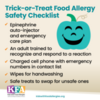Halloween means crisp fall air, pumpkins, and trick-or-treating. But for adults and kids who manage asthma and allergies, even the best parts of Halloween – like treats, costumes, and decorations – can be frightful triggers. Knowing how to avoid triggers can reduce stress and minimize the chances of a food allergy reaction or an asthma attack. Here are our tips to make your Halloween safer.
Take Precautions to Reduce the Spread of Respiratory Illnesses
COVID-19, the flu, respiratory syncytial virus (RSV), and other respiratory illnesses are currently spreading. The coronavirus that causes COVID-19 may cause serious illness. And many respiratory infections can cause complications that are serious for adults and children with asthma and allergies.
Get the flu shot as soon as possible. People 12 and older can get a COVID-19 vaccine. And don’t forget to wear a face mask that is made to reduce the spread of COVID-19 even if you are fully vaccinated, wash your hands often, avoid large crowds of people, and stay home if you’re sick.
Know What Is Safe to Eat If You Have Food Allergies
For most kids, Halloween is all about treats and candy! For kids with food allergies, this often means being excluded from the fun and being extra cautious around unsafe treats.
- Use our Allergy-Friendly Halloween Candy Guide to help you shop for candy free of the most common allergens.
- Remember that it’s important to read labels and avoid cross-contact of safe treats with allergens.
- Know how to prevent, recognize, and treat a severe allergic reaction called anaphylaxis [anna-fih-LACK-sis].
- Review your child's Anaphylaxis Action Plan with caregivers and give them a copy. If your child is older, they can help communicate with their friends and families.
- Look for houses with teal pumpkins which means they have non-food treats available.
- Use our Trick-or-Treat Food Allergy Safety Checklist to make sure you are prepared.

Check Costumes and Accessories
Kids look forward to dressing up as their favorite superhero, princess, or goblin all year! And so do many adults. Be sure costume pieces and accessories are not allergy or asthma triggers.
- Some masks and costumes may contain latex, nickel, and other allergens. Carefully read the labels on costumes and accessories.
- Avoid masks and costume pieces that are stored for long periods of time because they can collect dust mites, mold spores, and other allergens in storage. Even new costumes can carry dust mites, so make sure to wash them before wearing.
- Check any makeup, face paints, hairspray, or other products for allergens. Some of these things can cause contact dermatitis in sensitive people.
Avoid Allergy and Asthma Triggers
Dealing with allergies or asthma can spoil a fun night. If you or your child has asthma, remember to carry their quick-relief inhaler. Review your Asthma Action Plan and your doctor’s instructions about pre-treating before potentially being exposed to asthma triggers.
Watch for these asthma triggers and allergens during Halloween:
- Piles of leaves and hay bales can have mold spores and pollen that may trigger allergies or asthma.
- Other people’s homes may have cigarette smoke, dust, or pet dander that could trigger allergies or asthma.
- Scented candles and room fresheners can be asthma triggers. Use battery-operated candles to light up luminaries or jack-o'-lanterns.
- Dry ice and fog machines help set a spooky mood, but both can make breathing difficult, even for people without asthma.
- Spooky drinks or treats made with liquid nitrogen or dry ice may trigger asthma in sensitive people.
- Being scared can be a fun Halloween tradition, but strong emotions like fear or excitement can be asthma triggers. You may choose to avoid scary situations. Always ensure your child takes all of their asthma medicines as prescribed.
- Running from house to house while trick-or-treating or playing active games can trigger exercise-induced asthma. Be sure to follow your doctor's instructions about pre-treating before physical activity.
- A crisp fall night can expose you to dramatic changes in temperature, especially if you are going from a warm environment to a cold one. Wear a face mask if your costume doesn’t have one to help reduce the effects of the cold air.
Updated October 2021


Comments (2)